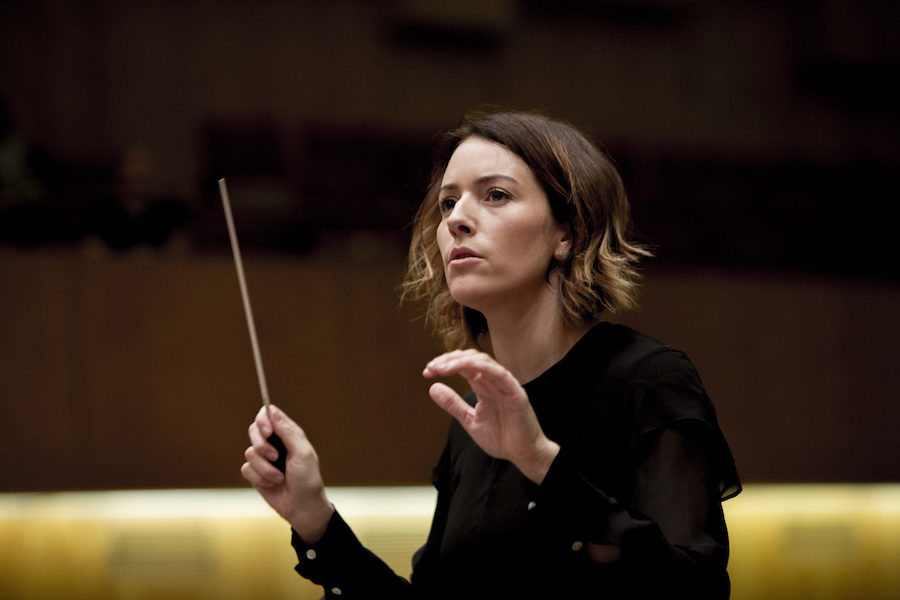What a treat it is to hear an evening of music that isn’t just the same old names. I realise that the standard contingent of composers with “B” last names are favourites that get bums on seats, but hey, I can confirm that this line-up of composers not named Bach, Beethoven or Brahms resulted in a completely packed QPAC. And look! A concert that isn’t just the tired combination of overture/concerto/symphony! The anticipation was almost palpable as the listeners filed into QPAC.
 Alondra de la Parra. Photo © Felix Broede
Alondra de la Parra. Photo © Felix Broede
Like the last few Queensland Symphony Orchestra concerts I’ve seen, the seemingly new policy of including spoken introductions makes an enormous difference. Here, Music Director Alondra de la Parra’s enthusiasm absolutely came through, complete with brief switches into Spanish to respond to cheers from the (very excited) audience. Likewise, the audience’s appreciation for the demonstration of the various unusual percussion instruments required for the performance was clear.
The concert began with Mexican composer Carlos Chávez’s Sinfonía india (Symphony No. 2). It uses three themes from the Seri and Yaqui people of Sonora (in the north of Mexico), and the Huicholes of Nayarit (in the central west). Chávez’s musical language here is pretty firmly neoclassical, sounding like Stravinsky with an added twist of percussion.
Brazilian guitarist Yamandu Costa has become a familiar face to Australian audiences; although I wasn’t in attendance, I heard absolutely rave reviews for his performances a couple of weeks ago at Guitar Perspectives in Melbourne. He was in a different mode for this evening’s concert in performing his Concerto Fronteira, which he describes as “an attempt to create a unique musical language that goes beyond [the guitar’s] virtuosity, in a rich and diverse style that is deeply connected with the culture of my homeland”. This was an absolute scene-stealer, and I don’t think I’ve ever seen an audience leap to their collective feet as quickly as they did at the end of this one.
Costa’s style is rather hard to describe, but if you imagine the flamboyance of a flamenco guitarist combined with the aching melodies and syncopations of Brazil, you’d be on the right track. Costa is a consummate showman, peering around his guitar to interact with the different sections of the chamber orchestra. It’s a cliché, but the man and the guitar were totally inseparable – he was the guitar, and the guitar was him. Special mention here must also go to the double bassists, and particularly acting section principal Justin Bullock, whose enthusiasm was absolutely infectious. With flashes of old film music in the orchestration and jaw-dropping virtuosity, Costa’s three-movement concerto was a total triumph, leaving the audience begging for more. If the three movements of technical wizardry weren’t enough, his encore left the audience in a stupor of pleasure. This semi-improvised piece included not only pitch-perfect whistling, but a vocal part as well! You’re welcome to come back to Brisbane any time, Yamandu.
The concert’s second half started with three dances (Dança Brasileira, Dança Selvagem and Dança Negra) by Camargo Guarnieri, one of the founding fathers of Brazilian music. These are wonderful miniatures, cleanly orchestrated in a Copland-ish style with occasional washes of acidic harmonies. De la Parra’s command of this repertoire is clear, clarifying syncopations and off-beat rhythms with ease, and bringing real Latin flavour to QSO.
Enrico Chapela’s inventive Ínguesu was in the program but was cut at the last minute, presumably to ensure that the running time wasn’t excessive. A pity, since de la Parra made an excellent recording of the piece in 2010 for Sony Classical. Next time, perhaps.
Villa-Lobos is probably the most well-known of the composers in this evening’s performance. As a classical guitarist, I’ve played plenty of his works, but I suspect that the Bachianas brasileiras are probably where you find the soul of Villa-Lobos – it’s in these pieces that his love of the music of Bach and of the music of Brazil are combined, sometimes surprisingly literally. QSO brought some punch to the four movements of the Bachianas brasileiras No. 7, although I can’t help but feel that the movements are unbalanced in quality. The Toccata and Fugue, for instance, have far more inventive colours and textures than the opening Prelude, though all were played well.
QSO were joined by several players from Brisbane Girls Grammar School as part of QSO’s Prossima program for José Pablo Moncayo’s Huapango, one of the most popular pieces of music by a Mexican composer. It’s a stirring work, built on several folk songs collected by Moncayo himself, and the young players fitted in perfectly with their QSO counterparts.
After a hugely rapturous call for an encore from the audience, de la Parra continued with Arturo Márquez’s Danzón No. 2. This was a fabulous closer, which turned into an audience clap-along at the invitation of de la Parra. She’s an incredibly talented and charismatic conductor, and QSO is definitely lucky to have her! This evening of rarely-heard-in-Australia repertoire was a complete success, and one which left the audience with smiles from ear to ear. Sign me up for part two, please.











Comments
Log in to join the conversation.